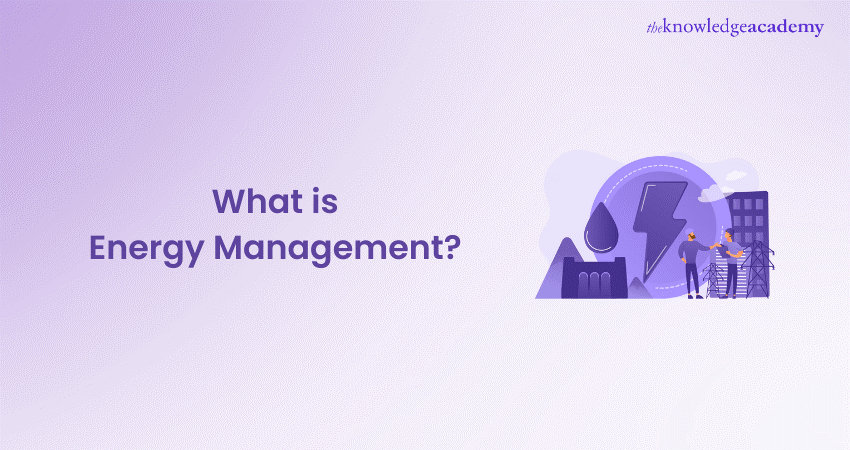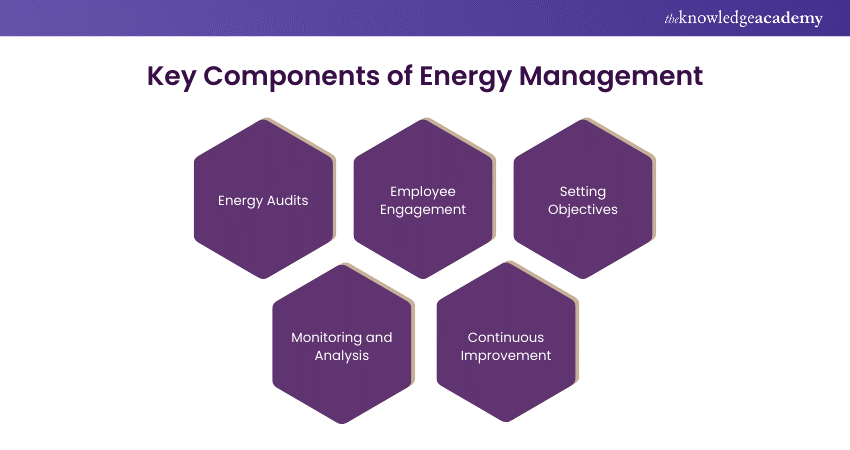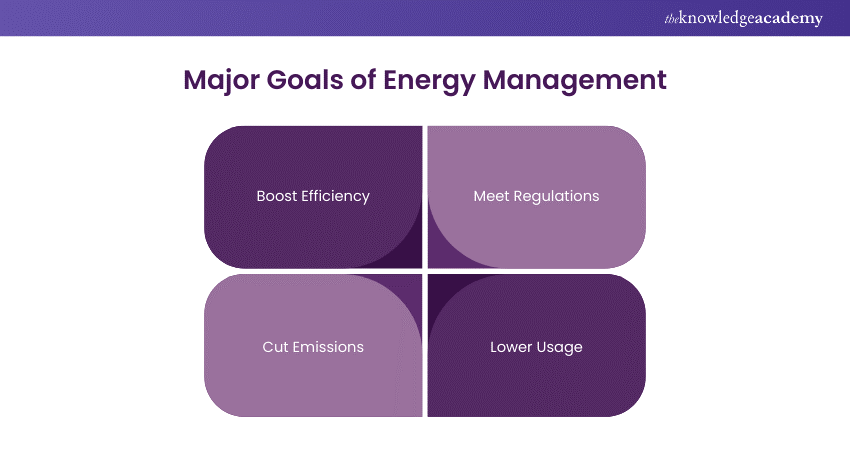We may not have the course you’re looking for. If you enquire or give us a call on +61 272026926 and speak to our training experts, we may still be able to help with your training requirements.
Training Outcomes Within Your Budget!
We ensure quality, budget-alignment, and timely delivery by our expert instructors.

Imagine this: every hour, a whopping 1,692 acres of once-productive land turn into barren wastelands due to environmental degradation, as stated by Worldcounts. It’s like Mother Earth is sending out an SOS signal, and we’re the ones who need to answer the call!
But fear not! Organisations and businesses are stepping up their game. They’re donning their eco-friendly capes, embracing sustainable energy practices, and minimising their ecological footprint. In this blog, you will learn What is Energy Management, along with its importance, key components, benefits, an introduction to an Energy Management Systems (EMS), and its widespread applications.
Table of Contents
1) Understanding What is Energy Management?
2) Key Components of Energy Management
3) Goals of Energy Management
4) The Benefits of Energy Management for Your Business
5) What are Energy Management Systems (EMS)?
6) Applications of Energy Management
7) Conclusion
Understanding What is Energy Management?
Energy Management is the strategy organisations use to minimise their environmental impact through a series of sustainable actions and processes. It involves optimising both energy production and consumption by improving workplace settings and incorporating various scientific methodologies. These methodologies include rainwater harvesting, natural cooling processes, solar heating, and green landscaping, all aimed at reducing the overall energy footprint.
By implementing effective Energy Management practices, organisations can significantly lower their operational costs, improve energy efficiency, and promote a healthier work environment. These efforts not only benefit the planet but also enhance an organisation’s reputation.
Key Components of Energy Management
Energy Management plays a crucial role in promoting environmental sustainability. It involves several key components, detailed below:

a) Energy Audits
Energy audits help identify inefficiencies in energy consumption and pinpoint areas for improvement. They highlight where energy use is excessive and suggest ways to enhance energy efficiency.
b) Employee Engagement
Engaging employees through incentives, training, and awareness campaigns encourages the adoption of sustainable practices. This fosters a genuine, long-term commitment to energy efficiency and sustainability within organisations.
c) Setting Objectives
Organisations should set clear objectives focused on reducing energy consumption, minimising waste, and increasing the use of renewable energy sources. Establishing performance metrics is essential to track and achieve these objectives.
d) Monitoring and Analysis
Ongoing monitoring of environmental impacts is vital for developing effective energy policies and plans. Regular analysis ensures these policies and plans are implemented effectively at all levels.
e) Continuous Improvement
Energy Management strategies must be continuously refined to keep pace with evolving technologies. Regular reviews ensure that Energy Management Systems remain current and compliant with the latest standards.
Enhance your energy efficiency with ISO 50001 Training Courses. Start your certification process today and take control!
Goals of Energy Management
While Energy Management settings are implemented to reduce the Greenhouse Gas (GHS) footprints, its major goals extend beyond environmental preservations. Here are those key goals:

Boost Efficiency
Improved energy efficiency involves using less energy to achieve higher output. This enhances productivity, reduces greenhouse gas emissions and energy bills, and fosters better customer satisfaction. Additionally, it benefits the environment by reducing the strain on natural resources.
Meet Regulations
Complying with government energy regulations provides organisations with several policy relaxations and enhances their brand image. This compliance can lead to significant cost savings and offer a competitive advantage by reducing energy costs.
Cut Emissions
Reducing energy requirements helps decrease CO2 and other harmful gas emissions from organisations and manufacturing industries. This contributes to mitigating the greenhouse effect and preserving the environment for future generations. Additionally, it can result in cost savings by lowering energy consumption.
Lower Usage
Reducing energy requirements helps decrease CO2 and other harmful gas emissions from organisations and manufacturing industries. This contributes to mitigating the greenhouse effect and preserving the environment for future generations. Additionally, it can result in cost savings by lowering energy consumption.
Become lead auditors in Energy Management Systems with our ISO 50001 Lead Auditor Training - join today!
The Benefits of Energy Management for Your Business
Energy Management is crucial in various organisational sectors that seek to minimise energy consumption and environmental impact. Let’s explore each of them below:
a) Manufacturing: Manufacturing industries, with their heavy machinery and high-power demands, benefit from Energy Management by reducing energy needs, optimising efficiency, and minimising polluted waste.
b) Hospitality: In the hospitality sector, Energy Management enhances energy efficiency in hotels, restaurants, and resorts, particularly in guest rooms, common areas, and kitchens.
c) Healthcare: Healthcare facilities require 24-hour power supply, especially in critical areas like operating rooms and labs. Energy Management ensures optimal power consumption and boosts energy efficiency.
d) Transportation: The transportation sector, with its extensive use of trucks and container ships, benefits from Energy Management through reduced fuel consumption and the adoption of energy-efficient practices.
e) Commercial Buildings: Energy Management in commercial buildings involves monitoring HVAC systems, lighting, and other equipment to implement effective energy policies and improve efficiency.
f) Government and Public Sector: Government buildings and public facilities utilise Energy Management to set and achieve energy-saving goals, fostering environmental leadership and implementing efficient energy policies.
Stay one step ahead In Energy Management Systems with ISO 50001 Lead Implementer Training—join today!
What are Energy Management Systems (EMS)?
Energy Management Systems (EMS) comprise tools, processes, and technologies designed to optimise energy usage within an organisation. Essentially, they are the practical application of Energy Management.
Energy Management Systems (EMS) involves identifying inefficiencies, monitoring energy consumption across facilities, and implementing strategies to reduce energy usage without compromising on production or service delivery.
Below described are the key aspects of EMS:
a) Energy Monitoring: Continuously track energy consumption across all facilities to identify patterns and areas of excessive use.
b) Efficiency Identification: Pinpoint key areas where energy is wasted and devise methods to address these inefficiencies.
c) Strategy Implementation: Develop and execute plans to reduce energy consumption while maintaining or improving production and service standards.
d) Cost Reduction: Lower energy bills by using resources more efficiently.
e) Sustainability Goals: Contribute to the organisation's sustainability objectives by reducing its carbon footprint.
f) Regulatory Compliance: Ensure adherence to energy-related regulations and standards.
Master the basics with ISO 50001 Foundation Training. Secure your spot and start learning today!
Applications of Energy Management
To effectively implement Energy Management Systems (EMS) at the ground level, the organisation's energy policies need to be translated into actionable steps through practical applications. These valuable applications are described below:
a) Grid Monitoring System
The grid monitoring system combines power supply monitoring, load balancing, and metering to ensure safe and efficient power delivery. It helps detect potential faults and outages in power grids, reduces energy costs, and facilitates rapid repairs and power restoration.
b) Smart Appliances
As digital technology advances, conventional electrical appliances are being replaced with smart alternatives that require less power. These include LED televisions, voice-activated lighting systems, and Wi-Fi-enabled air conditioners, which are more efficient, eco-friendly, and consume less energy than traditional appliances.
c) Renewable Forms of Electricity
Renewable electrical energy sources, such as wind and tidal energy, have recently gained significant traction. These sources are steadily replacing conventional dam-operated or steam turbine electricity, generating power without harming the environment. Their growing popularity is due to their potential to reduce carbon emissions and combat climate change.
Conclusion
Understanding Energy Management and its applications, benefits, and key components is vital for navigating the complex energy market. Energy Management Systems (EMS) go beyond corporate use, becoming essential in combating rising greenhouse gas emissions. EMS helps optimise energy consumption, save costs, and reduce environmental impact. Embracing EMS leads to a sustainable, energy-efficient future, benefiting both the economy and the environment.
Become an Internal Auditor in Energy Management Systems with our ISO 50001 Internal Auditor Training- join today!
Frequently Asked Questions

The four crucial elements of Energy Management are energy policies, objectives and targets, efficiency improvement plans, and monitoring, measuring & analysis.

The three major steps involved in Energy Management are energy production, energy transmission, and energy usage.

The Knowledge Academy takes global learning to new heights, offering over 30,000 online courses across 490+ locations in 220 countries. This expansive reach ensures accessibility and convenience for learners worldwide.
Alongside our diverse Online Course Catalogue, encompassing 17 major categories, we go the extra mile by providing a plethora of free educational Online Resources like News updates, Blogs, videos, webinars, and interview questions. Tailoring learning experiences further, professionals can maximise value with customisable Course Bundles of TKA.

The Knowledge Academy’s Knowledge Pass, a prepaid voucher, adds another layer of flexibility, allowing course bookings over a 12-month period. Join us on a journey where education knows no bounds.

The Knowledge Academy offers various ISO 50001 Certification, including the ISO 50001 Foundation Training, ISO Lead Auditor and Internal Auditor Course. These courses cater to different skill levels, providing comprehensive insights into the Conventional Sources of Energy.
Our IT Service Management Blogs cover a range of topics related to ISO 17020, offering valuable resources, best practices, and industry insights. Whether you are a beginner or looking to advance your knowledge of Energy Management, The Knowledge Academy's diverse courses and informative blogs have got you covered.







 Top Rated Course
Top Rated Course




 If you wish to make any changes to your course, please
If you wish to make any changes to your course, please


